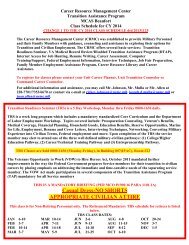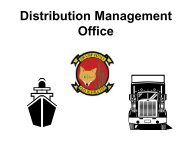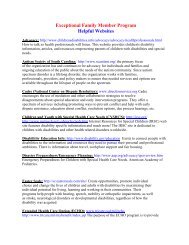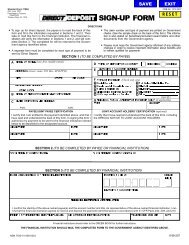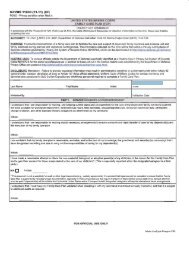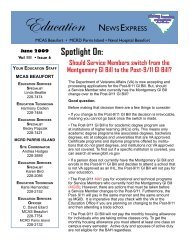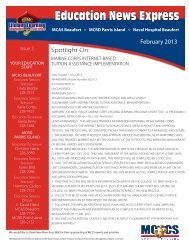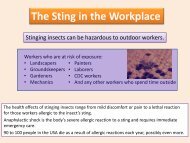- Page 1 and 2:
NAVMC DIR 5100.8SDMay 15, 2006NAVMC
- Page 3 and 4:
NAVMC DIR 5100.8MARINE CORPSOCCUPAT
- Page 6 and 7:
MARCOR OSH PROGRAM MANUALRECORD OF
- Page 8 and 9:
CHAPTERPAGE17 HAZARDOUS MATERIALS C
- Page 11 and 12:
MARCOR OSH PROGRAM MANUALCHAPTER 1I
- Page 13 and 14:
MARCOR OSH PROGRAM MANUAL 10032. Qu
- Page 15 and 16:
MARCOR OSH PROGRAM MANUAL 10041004.
- Page 17:
MARCOR OSH PROGRAM MANUALCHAPTER 2R
- Page 20 and 21:
2000 MARCOR OSH PROGRAM MANUAL(5) I
- Page 22 and 23:
2000 MARCOR OSH PROGRAM MANUALdirec
- Page 24 and 25:
2002 MARCOR OSH PROGRAM MANUAL8. En
- Page 26 and 27:
2003 MARCOR OSH PROGRAM MANUALb. Al
- Page 28 and 29:
2003 MARCOR OSH PROGRAM MANUALappro
- Page 30:
MARCOR OSH PROGRAM MANUALCHAPTER 3S
- Page 33 and 34:
3000 MARCOR OSH PROGRAM MANUALinteg
- Page 35 and 36:
3001 MARCOR OSH PROGRAM MANUALe. On
- Page 37 and 38:
3001 MARCOR OSH PROGRAM MANUALany o
- Page 39:
MARCOR OSH PROGRAM MANUALCHAPTER 4C
- Page 42 and 43:
4001 MARCOR OSH PROGRAM MANUAL3. Pu
- Page 44 and 45:
4002 MARCOR OSH PROGRAM MANUALkept
- Page 47 and 48:
MARCOR OSH PROGRAM MANUALCHAPTER 5T
- Page 49 and 50: MARCOR OSH PROGRAM MANUAL 5001Motor
- Page 51 and 52: MARCOR OSH PROGRAM MANUAL 50017. Sa
- Page 53 and 54: MARCOR OSH PROGRAM MANUAL 5003coord
- Page 56 and 57: MARCOR OSH PROGRAM MANUALCHAPTER 6O
- Page 58 and 59: MARCOR OSH PROGRAM MANUAL 6003explo
- Page 60 and 61: MARCOR OSH PROGRAM MANUAL 6005c. A
- Page 62: MARCOR OSH PROGRAM MANUALCHAPTER 7W
- Page 65 and 66: 7002 MARCOR OSH PROGRAM MANUAL2. In
- Page 67 and 68: 7003 MARCOR OSH PROGRAM MANUALc. Ne
- Page 69 and 70: 7004 MARCOR OSH PROGRAM MANUALe. En
- Page 72 and 73: MARCOR OSH PROGRAM MANUAL 7006any p
- Page 74 and 75: MARCOR OSH PROGRAM MANUAL 70102. Th
- Page 76 and 77: MARCOR OSH PROGRAM MANUALRISK ASSES
- Page 78: MARCOR OSH PROGRAM MANUALCHAPTER 8F
- Page 81 and 82: 8001 MARCOR OSH PROGRAM MANUALLaw 9
- Page 83 and 84: 8003 MARCOR OSH PROGRAM MANUALa. US
- Page 85: MARCOR OSH PROGRAM MANUALCHAPTER 9R
- Page 88 and 89: 9002 MARCOR OSH PROGRAM MANUALadvis
- Page 90 and 91: 9003 MARCOR OSH PROGRAM MANUALThe a
- Page 92 and 93: 9006 MARCOR OSH PROGRAM MANUAL3. Pe
- Page 94 and 95: MARCOR OSH PROGRAM MANUALSAMPLELOG
- Page 96 and 97: MARCOR OSH PROGRAM MANUALDid any of
- Page 99: MARCOR OSH PROGRAM MANUALCHAPTER 10
- Page 103 and 104: MARCOR OSH PROGRAM MANUAL 100032. D
- Page 105: MARCOR OSH PROGRAM MANUALCHAPTER 11
- Page 108 and 109: 11001 MARCOR OSH PROGRAM MANUALsubs
- Page 110 and 111: 11001 MARCOR OSH PROGRAM MANUALb. T
- Page 112 and 113: 11005 MARCOR OSH PROGRAM MANUALthe
- Page 114 and 115: MARCOR OSH PROGRAM MANUALFIGUREPAGE
- Page 116 and 117: 12000 MARCOR OSH PROGRAM MANUAL(1)
- Page 118 and 119: 12002 MARCOR OSH PROGRAM MANUAL1. C
- Page 120 and 121: 12003 MARCOR OSH PROGRAM MANUALc. L
- Page 122 and 123: 12005 MARCOR OSH PROGRAM MANUALthe
- Page 124 and 125: 12008 MARCOR OSH PROGRAM MANUAL1200
- Page 126 and 127: 12013 MARCOR OSH PROGRAM MANUALa. A
- Page 128 and 129: MARCOR OSH PROGRAM MANUALFigure 12-
- Page 130 and 131: MARCOR OSH PROGRAM MANUALSAMPLE LOC
- Page 133 and 134: MARCOR OSH PROGRAM MANUALCHAPTER 13
- Page 135 and 136: MARCOR OSH PROGRAM MANUAL 130042. P
- Page 137 and 138: MARCOR OSH PROGRAM MANUAL 13006b. 1
- Page 139 and 140: MARCOR OSH PROGRAM MANUAL 130074. T
- Page 141 and 142: MARCOR OSH PROGRAM MANUAL 13008quar
- Page 143 and 144: MARCOR OSH PROGRAM MANUAL 13008g. P
- Page 145 and 146: MARCOR OSH PROGRAM MANUAL 13008h. C
- Page 147 and 148: MARCOR OSH PROGRAM MANUAL 1300815.
- Page 150 and 151:
MARCOR OSH PROGRAM MANUALCHAPTER 14
- Page 152 and 153:
MARCOR OSH PROGRAM MANUAL 14002inst
- Page 154 and 155:
MARCOR OSH PROGRAM MANUAL 14002(2)
- Page 156 and 157:
MARCOR OSH PROGRAM MANUAL 14002rest
- Page 158 and 159:
MARCOR OSH PROGRAM MANUAL 14003resc
- Page 160 and 161:
MARCOR OSH PROGRAM MANUAL 14004c. C
- Page 162 and 163:
MARCOR OSH PROGRAM MANUAL 14008requ
- Page 164 and 165:
MARCOR OSH PROGRAM MANUALFigure 14-
- Page 167 and 168:
MARCOR OSH PROGRAM MANUALCHAPTER 15
- Page 169 and 170:
MARCOR OSH PROGRAM MANUAL 15004Cont
- Page 171 and 172:
MARCOR OSH PROGRAM MANUAL 15004Tabl
- Page 173 and 174:
MARCOR OSH PROGRAM MANUAL 15005b. C
- Page 175 and 176:
MARCOR OSH PROGRAM MANUAL 15006(4)
- Page 177 and 178:
MARCOR OSH PROGRAM MANUAL 15007Fiel
- Page 179 and 180:
MARCOR OSH PROGRAM MANUALFFigure 15
- Page 181 and 182:
MARCOR OSH PROGRAM MANUALAsbestos T
- Page 183 and 184:
MARCOR OSH PROGRAM MANUALAsbestos T
- Page 186 and 187:
MARCOR OSH PROGRAM MANUALCHAPTER 16
- Page 188 and 189:
MARCOR OSH PROGRAM MANUAL 160032. A
- Page 190 and 191:
MARCOR OSH PROGRAM MANUAL 16004c. I
- Page 192 and 193:
MARCOR OSH PROGRAM MANUAL 16008g. I
- Page 194:
MARCOR OSH PROGRAM MANUALCHAPTER 17
- Page 197 and 198:
17001 MARCOR OSH PROGRAM MANUALThes
- Page 199 and 200:
17004 MARCOR OSH PROGRAM MANUAL1700
- Page 201 and 202:
17006 MARCOR OSH PROGRAM MANUALb. C
- Page 203 and 204:
17008 MARCOR OSH PROGRAM MANUALc. L
- Page 205 and 206:
17008 MARCOR OSH PROGRAM MANUAL4. L
- Page 207 and 208:
17008 MARCOR OSH PROGRAM MANUAL6. M
- Page 209:
MARCOR OSH PROGRAM MANUALCHAPTER 18
- Page 212 and 213:
18002 MARCOR OSH PROGRAM MANUALa. C
- Page 214 and 215:
18002 MARCOR OSH PROGRAM MANUALbeen
- Page 216 and 217:
18003 MARCOR OSH PROGRAM MANUALe. W
- Page 218:
MARCOR OSH PROGRAM MANUALCHAPTER 19
- Page 221 and 222:
19000 MARCOR OSH PROGRAM MANUALmay
- Page 223 and 224:
19002 MARCOR OSH PROGRAM MANUAL2. T
- Page 225 and 226:
19002 MARCOR OSH PROGRAM MANUAL8. T
- Page 227 and 228:
19003 MARCOR OSH PROGRAM MANUAL3. H
- Page 229:
MARCOR OSH PROGRAM MANUALCHAPTER 20
- Page 232 and 233:
20001 MARCOR OSH PROGRAM MANUAL2. S
- Page 234 and 235:
20004 MARCOR OSH PROGRAM MANUAL2000
- Page 236 and 237:
MARCOR OSH PROGRAM MANUALAPPENDIX A
- Page 238 and 239:
MARCOR OSH PROGRAM MANUAL33. DoDDIR
- Page 240 and 241:
MARCOR OSH PROGRAM MANUAL64. NIOSH
- Page 242 and 243:
MARCOR OSH PROGRAM MANUALAPPENDIX B
- Page 244 and 245:
MARCOR OSH PROGRAM MANUALa. A flash
- Page 246 and 247:
MARCOR OSH PROGRAM MANUAL24. Parent
- Page 248:
MARCOR OSH PROGRAM MANUALnerves, jo



